
The term 'Calculation Engine' is used here to describe a method whereby calculations can be performed using formulae that are obtained from the database instead of being hard-wired into any program code. This means that adjustments to the formulae can be made very quickly using a normal data entry screen instead of requiring a programmer to go into the source code, then amend, compile and release it. As you know this is a very time-consuming and expensive process. The Calculation Engine needs to be compiled and released only once - all subsequent customisation of the formulae is simply a matter of changing data. The only arithmetic statements that are hard-wired into the Calculation Engine are:
ADD something TO something SUBTRACT something FROM something MULTIPLY something BY something DIVIDE something BY something
where the various something elements are identified at run time from the contents of the FORMULA-LINE table.
Several years ago I was asked to help a sister company to build a payroll package in UNIFACE. This was to replace the several different versions they had which ran on different platforms with a single 'open' solution. As well as giving them some guidance in how to develop applications in UNIFACE I was asked if I could design some advanced features which did not exist in any of their existing systems. One of these was a flexible organisational hierarchy which is documented in my article A Flexible Tree Structure. Another was a Calculation Engine, which is the subject of this paper.
One of the problems with selling a standard payroll package to lots of different customers is that some customers have requirements, such as the calculation of Profit Related Pay (PRP), which are totally unique. It was getting a bit tedious to keep releasing software with the different calculations hard-wired into the code, so a more flexible solution was sought.
One of the salesmen had seen a rival package where some formulae could be user-defined in SQL statements, but as that package was tied to a particular database it was not really 'open' enough. What I wanted to do was produce a solution that was 100% pure UNIFACE so that it would be truly portable across any platform and any database. I ended up with a solution where not just the PRP but the entire payslip could be calculated using formulae that were obtained from the database. These formulae are accessible via normal data entry screens, thus can be maintained by any user who is familiar with the command syntax. A truly flexible solution that should be able to cope with any situation without requiring the intervention of an expensive programmer.
I should mention that up until this point I had never worked on any payroll system whatsoever, and when I asked for the specific requirements for some of the calculations all I got were copies of one of their User Guides and some database layouts. This meant that in some cases I had to make educated guesses based on nothing more than the fact that I had been on the receiving end of payslips for many years. Some of you may spot errors in some of my formulae, but you should also be quick to realise that any mistakes can be corrected very easily without having to change any program code. Well, that's my excuse and I'm sticking to it.
Figure 1 - Entity-Relationship Diagram

In this E-R diagram the arrowhead identifies the MANY in each ONE-to-MANY relationship.
| table name | contents |
|---|---|
| PAYGROUP | PAYGROUP_ID, paygroup_desc |
| EMPLOYEE | EMPLOYEE_ID, paygroup_id, employee_name, blah, blah, blah |
| PAYCODE-IN | EMPLOYEE_ID, PAYCODE_ID, DATE-SEQ, input-hours, input-value, input-percent, start-date, end-date, node_id |
| PAY-PERIOD | PAYGROUP-ID, PAY-YEAR, PAY-PERIOD, start-date, end-date, pay-date |
| PAYSLIP | EMPLOYEE-ID, PAYSLIP-ID, paygroup-id, pay-year, pay-period |
| PAYCODE-OUT | EMPLOYEE-ID, PAYSLIP-ID, PAYCODE-ID, output-value |
| PAYCODE | PAYCODE-ID, sort-seq, paycode-desc, paycode-type, allow-hours, allow-value, allow-percent, allow-node |
| FORMULA | PAYCODE-ID, DATE-SEQ, start-date, end-date |
| FORMULA-LINE | PAYCODE-ID, DATE-SEQ, LINE-NO, formula-line |
| RATE-TABLE | TABLE-ID, table-desc |
| TABLE-DATE | TABLE-ID, DATE-SEQ, start-date, end-date |
| TABLE-ENTRY | TABLE-ID, DATE-SEQ, ENTRY-SEQ, rate-band, rate-amount |
I have simplified the contents here in order to remove unnecessary complications. The primary key fields are shown in upper case, and the foreign keys should be obvious.
As I have stated previously my only contact with any sort of payroll system before this point was nothing more than receiving a payslip at the end of each month, so I started off by studying a payslip for inspiration. I noticed immediately that each amount had a unique identifier, such as TAX-CODE, SALARY, TAX-PAID, NET-PAY and so on, so this identifier became my PAYCODE-ID. Each PAYCODE also has its own method for producing an amount, either by direct input or a specific calculation, so these methods became my FORMULAE. Each FORMULA is maintained via a standard UNIFACE form using plain English statements that are described in section The Command Syntax for defining a Formula which is defined below.
| PAYCODE-ID | A user-defined string that defines each element in a payslip. |
| PAYCODE-DESC | A description for this PAYCODE entry. |
| SORT-SEQ | Defines the order in which the various formulae are processed. |
| PAYCODE-TYPE | Either 'input allowed' or 'output only'. Only those with 'input allowed', such as TAX-CODE and SALARY, can appear on the PAYCODE-IN table. |
| ALLOW-VALUE | Options are: NONE, Numbers only, Letters only, or Both. If PAYCODE-TYPE is 'output only' then this can only be 'NONE'. This determines the format of the INPUT-VALUE field on the PAYCODE-IN table. For example, TAX-CODE is a mixture of numbers and letters, while SALARY must be numbers only. |
| ALLOW-HOURS | BOOLEAN: if YES then the PAYCODE-IN occurrence can contain a number of hours. This can be used to identify how many hours were worked on a particular task, either as a calculation of wages or for charging that amount to the relevant nominal code in the accounting system. |
| ALLOW-PERCENT | BOOLEAN: if YES then the PAYCODE-IN occurrence can contain a percentage value. This can be used to determine the amount which the employee pays into a pension scheme, for example. |
| ALLOW-NODE | BOOLEAN: if YES then the PAYCODE-IN occurrence can contain a NODE-ID. This is used to identify an entry in the structure hierarchy, such as project code or department, to which to which the amount is to be charged. This structure hierarchy is described in a separate paper called A Flexible Tree Structure. |
Figure 2 - Screenshot of PAYCODE-IN (summary)
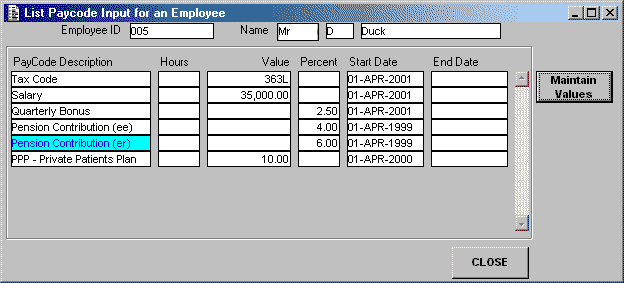
The PAYCODE-IN table contains the variables that are required for each individual EMPLOYEE, such as TAX-CODE, SALARY, etc. Each entry has a start and end date so that a full history of all changes can be maintained. This is implemented using a standard design technique which I have documented in a separate paper called Keeping a history of changes by date. This means that when a payroll calculation is performed for a specific date then only those values that apply to that date are included.
For some employees the data here can be fairly static, but for others it may involve the input of a weekly timesheet to record the number of hours worked on a particular task, either for the calculation of wages or to identify to whom the amount is to be charged.
Figure 2 shows all the current input values that apply to this particular employee. Figure 3 shows the complete history for one of those paycodes.
Figure 3 - Screenshot of PAYCODE-IN (detailed history)
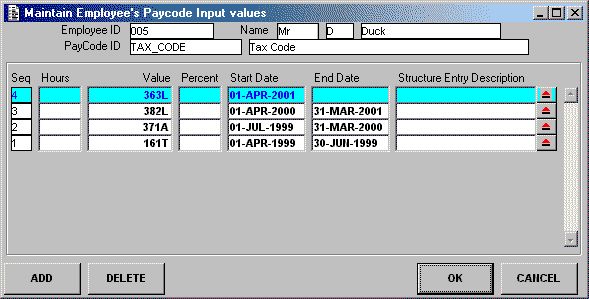
Figure 3 shows the history of one particular PAYCODE-ID showing how the value has changed over a period of time. Entries can be input with a future start date and will not be processed until that date is specified for the calculation.
Figure 4 - Screenshot of RATE-TABLE entries
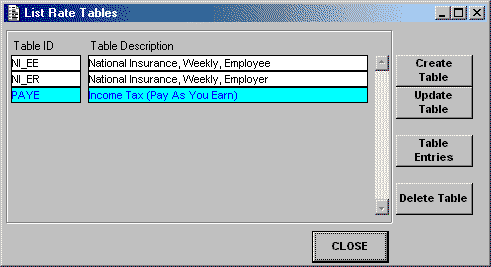
Instead of having a separate set of database tables for each different set of rates, e.g. tax rates and national insurance rates, I decided to maintain them all on one set of tables. Each different set of rates is identified by its own TABLE-ID, as shown in Figure 4.
Figure 5 - Screenshot of TABLE-DATE and TABLE-ENTRY entries
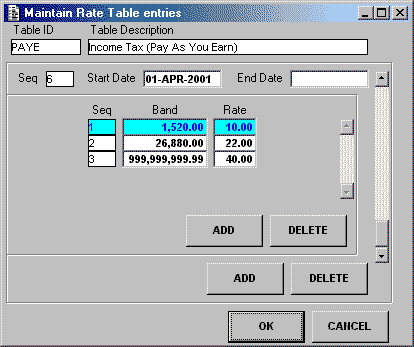
As is usual there can be different sets of values for each TABLE-ID for different time periods. Figure 5 shows the PAYE rates that came into force on April 1st 2001. This shows that the first ?1,520 will be taxed at 10%, the next ?26,880 will be taxed at 22%, and the remainder will be taxed at 40%. Entries can be input with a future start date and will not be processed until that date is specified for the calculation.
Figure 6 - Screenshot of the FORMULA and FORMULA-LINE tables
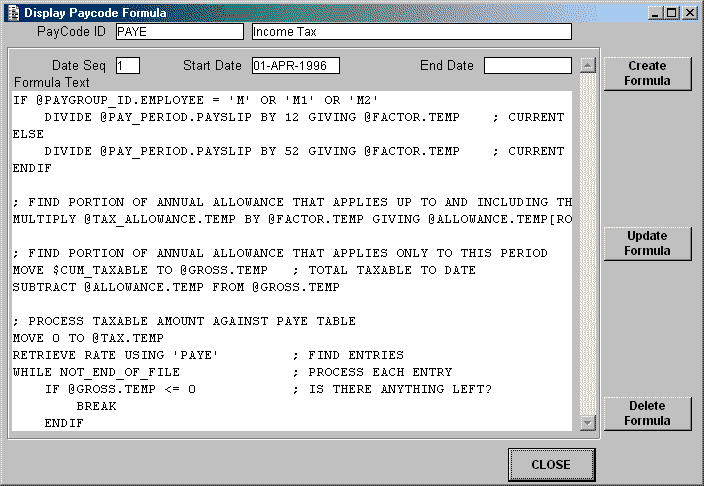
Figure 6 shows a screen displaying the formula for one of the paycodes. Notice again that the formula for each paycode may change over a period of time, but each change is held with its own start and end dates. When a calculation run is processed for a specific date only the version which applies to that date will be used.
Although each line of the formula is held on a separate database occurrence these are all merged into a single multi-line field for display and maintenance purposes. Large formulae can be better accessed by using the ZOOM function on the field. The grammar used to define each formula is described in section The Command Syntax for defining a Formula.
The PAYGROUP table is simply a method of breaking down the list of employees into different processing groups, such as monthly paid, weekly paid, directors, etc. Each payslip run starts off by selecting a PAYGROUP and a PAY-PERIOD, then all the employees in that group are processed one at a time using the variables that apply to the specified PAY-PERIOD.
The PAY-PERIOD table is used to define the applicable dates for the next payslip calculation run for employees in the PAYGROUP.
The PAYSLIP table is used to record whenever a payslip is generated for an employee. The PAYSLIP-ID starts at 1 for each employee and is incremented by 1 for each new payslip.
Figure 7 - Screenshot of the PAYCODE-OUT table
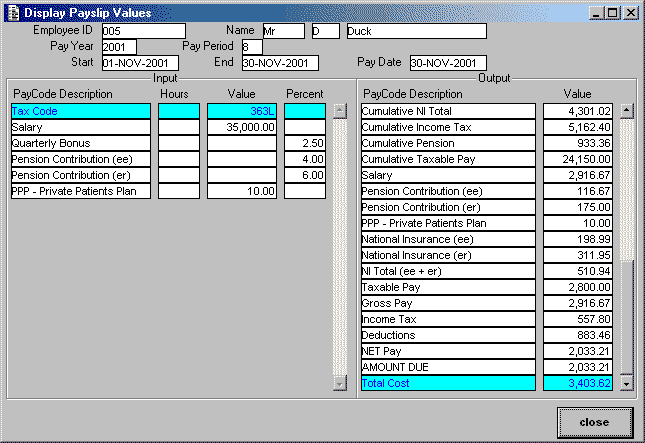
The PAYCODE-OUT table contains the output from all payslip calculations. Note that not all of the entries will actually appear on the printed payslip. Some values are required so that they can be carried forward into the next calculation, other values are required because they must be entered into an external accounting system.
None of the cumulative values, such as GROSS-PAY-TO-DATE or TAXABLE-PAY-TO-DATE are held on the EMPLOYEE record, they are all held here. Whenever any calculation requires one of these cumulative amounts it obtains it by looking at the contents of the previous payslip. This is easily identified as the PAYSLIP-ID of the previous payslip is always 1 less than the PAYSLIP-ID of the current payslip.
I make absolutely no apologies for the fact that my command syntax has an extremely close resemblance to those found in the COBOL language. It was, after all, my primary language for 16 years before I switched to UNIFACE. A colleague tried to suggest that I use something similar to C++ notation, but I prefer using plain English, not gobbledegook.
Each line of a formula should consist of a single statement terminated by a carriage return. For a statement to be valid it must match one of the following:
MOVE <input> TO <output> ADD <input> TO <input-output> ADD <input> TO <input> GIVING <output> SUBTRACT <input> FROM <input-output> SUBTRACT <input> FROM <input> GIVING <output> MULTIPLY <input-output> BY <input> MULTIPLY <input> BY <input> GIVING <output> DIVIDE <input-output> BY <input> DIVIDE <input> BY <input> GIVING <output> RETRIEVE <table_name> USING <table_id> READ <table_name> READ <table_name> USING <record_number> IF <logical expression> statement .... ELSE statement .... ENDIF WHILE <logical expression> statement .... ENDWHILE REPEAT statement .... UNTIL <logical expression> BREAK - terminate the current WHILE-ENDWHILE or REPEAT-UNTIL loop. STOP - stop further processing of the current formula
Blank lines are allowed to separate logical blocks of code
A ';' (semi-colon) denotes the start of comments, which will be ignored when processing the formula. Comments are allowed to follow statements on the same line, or can be on lines of their own.
Note that it is not necessary for a PAYCODE to have a FORMULA which provides the value for that PAYCODE. It is possible for values to be set during the processing of formulae for other PAYCODEs.
<input> defines an input source, which can be one of the following:
NOTE1: Percentage values will automatically be divided by 100 before being used in any calculation.
<output> defines an output destination, which must be:-
$NET_PAY. If the value is non-zero at the end of the calculation a record will be added to the PAYCODE_OUT table.<output> values can be rounded UP or DOWN as required:
<output>[ROUND,n] - the value in <output> will be rounded UP<output>[TRUNC,n] - the value in <output> will be rounded DOWNThe digit after the ROUND or TRUNC specification identifies where the rounding is to take place:
Either of the following constructs is valid:
IF <logical expression> statement .... ELSE statement .... ENDIF
or
IF <logical expression> statement .... ENDIF
An IF statement may be nested inside another IF or LOOP statement to any number of levels.
IF <logical expression>
IF <logical expression>
statement
....
ENDIF
ENDIF
The WHILE-ENDWHILE loop will execute all enclosed statements until <logical expression> is FALSE, and will evaluate the expression before each iteration. If <logical expression> is FALSE to begin with then the statements are never executed.
The REPEAT-UNTIL loop will execute all enclosed statements until <logical expression> is TRUE, and will evaluate the expression after each iteration. If <logical expression> is TRUE to begin with then the statements are executed only once.
BREAK will terminate the current WHILE-ENDWHILE or REPEAT-UNTIL loop.
An LOOP statement may be nested inside another IF or LOOP statement to any number of levels.
<logical expression> is in the format <input1> RELOP <input2>, where RELOP is the Relational Operator which is used to compare the two <input> values. It must be one of the following:
= (equal to) != (not equal to) < (less than) <= (less than or equal to) > (greater than) >= (greater than or equal to)
If RELOP is '=' (equal to) then up to 4 choices are allowed, as in:
IF @PAY_PERIOD.PAYSLIP = 3 or 6 or 9 or 12 WHILE @PAY_PERIOD.PAYSLIP = 3 or 6 or 9 or 12 UNTIL @PAY_PERIOD.PAYSLIP = 3 or 6 or 9 or 12
or
IF INPUT_VALUE(A) = 'A' OR 'B' OR 'C' OR 'D'
Following a RETRIEVE or READ command the following conditions are set to either TRUE or FALSE as appropriate:
END_OF_FILE (no more records exist) NOT_END_OF_FILE (record exists)
These two expressions can be used in statements as follows:
IF (NOT_)END_OF_FILE UNTIL END_OF_FILE WHILE NOT_END_OF_FILE
RETRIEVE <table_name> USING <table_id> READ <table_name> READ <table_name> USING <record_number>
<table-name> identifies the database table to be processed. Currently the only database table which can be accessed this way is the RATE table.
<table_id> identifies the primary key value for table entry, which must exist on that table.
<record_number> is a numeric literal or an <input> value which contains a number.
RETRIEVE will establish a hitlist for a set of database records, making them available for subsequent READ operations. If the RETRIEVE is successful it will perform an automatic READ of the first record, and will set END_OF_FILE to FALSE (and NOT_END_OF_FILE to TRUE).
Subsequent database records can be obtained with the READ command. If the USING <record_number> argument is used this will obtain the record with that occurrence number in the hitlist, otherwise the next available record will become the current record.
If there is no next record, or <record_number> is invalid, END_OF_FILE will be set to TRUE (and NOT_END_OF_FILE to FALSE).
IF @PAY_PERIOD.PAYSLIP = 1
MOVE 0 TO $CUM_BASIC
ELSE
MOVE $CUM_BASIC(B/F) TO $CUM_BASIC
ENDIF
Here the value for $CUM_BASIC is set to zero at the beginning of each year, and in other periods the value from the previous payslip is brought forward.
; STORE THIS FOR BONUS CALCULATION MOVE INPUT_VALUE TO @SALARY.TEMP ; GET MONTHLY AMOUNT FROM ANNUAL SALARY DIVIDE INPUT_VALUE BY 12 GIVING @HOLD.TEMP[ROUND,2] ; MOVE @HOLD.TEMP TO $BASIC ADD @HOLD.TEMP TO $CUM_BASIC MOVE @HOLD.TEMP TO $GROSS MOVE @HOLD.TEMP TO $NET MOVE @HOLD.TEMP TO $TAXABLE MOVE @HOLD.TEMP TO @PENSIONABLE.TEMP
This divides the annual salary by 12 to get the monthly amount (basic pay). Notice how other values used in the calculation process are affected at this point.
Notice that the amount of salary which is pensionable is held as a temporary variable (@PENSIONABLE.TEMP) instead of being output to PAYCODE-OUT ($PENSIONABLE) as it does not require to be printed on the payslip, accumulated for future payslips, or exported to an external accounting system.
IF INPUT_VALUE(A) = 'E' OR 'K'
MOVE 0 TO @TAX_ALLOWANCE.TEMP
STOP
ENDIF
MULTIPLY INPUT_VALUE BY 10 GIVING @TAX_ALLOWANCE.TEMP
If the TAX-CODE is input as '363L' then:
INPUT_VALUE(A) would provide 'L'INPUT_VALUE would provide '363'
MULTIPLY @PENSIONABLE.TEMP BY INPUT_PERCENT GIVING @HOLD.TEMP[ROUND,2]
IF INPUT_VALUE > @HOLD.TEMP
MOVE INPUT_VALUE TO @HOLD.TEMP
ENDIF
;
MOVE @HOLD.TEMP TO $PENSION_1
ADD @HOLD.TEMP TO $CUM_PENSION_1
SUBTRACT @HOLD.TEMP FROM $TAXABLE
SUBTRACT @HOLD.TEMP FROM $NET
ADD @HOLD.TEMP TO $DEDUCTIONS
This is where an employee's pension contributions are initially expressed as a percentage of basic pay, but can be replaced by a specified amount if this is a higher value.
MULTIPLY INPUT_HOURS BY INPUT_VALUE GIVING @HOLD.TEMP ADD @HOLD.TEMP TO $HOURLY ADD @HOLD.TEMP TO $CUM_HOURLY ADD @HOLD.TEMP TO $GROSS ADD @HOLD.TEMP TO $NET ADD @HOLD.TEMP TO $TAXABLE
This is where the PAYCODE-IN record contains both a number of hours and an hourly rate.
; ONLY PROCESS AT THE END OF EACH QUARTER
IF @PAY_PERIOD.PAYSLIP = 3 OR 6 OR 9 OR 12
IF INPUT_VALUE > 0
; USE SPECIFIED VALUE
MOVE INPUT_VALUE TO @HOLD.TEMP
ELSE
; USE A PERCENTAGE OF ANNUAL SALARY
MULTIPLY @SALARY.TEMP BY INPUT_PERCENT GIVING @HOLD.TEMP[ROUND,2]
ENDIF
MOVE @HOLD.TEMP TO $BONUS_Q
ADD @HOLD.TEMP TO $CUM_BONUS_Q
ADD @HOLD.TEMP TO $GROSS
ADD @HOLD.TEMP TO $NET
ADD @HOLD.TEMP TO $TAXABLE
ENDIF
This calculates a quarterly bonus, which is why it is not included in every period. The amount can either be a percentage of the annual salary or a specific amount.
The basic code looks something like this:
RETRIEVE RATE USING 'PAYE' ; FIND ENTRIES
WHILE NOT_END_OF_FILE ; PROCESS EACH ENTRY
....
READ RATE ; READ NEXT ENTRY
ENDWHILE
or
RETRIEVE RATE USING 'PAY-BAND' ; FIND ENTRIES
READ RATE USING INPUT_VALUE ; READ 'Nth' OCCURRENCE
When part of a complete formula it can look something like this:
IF @PAYGROUP_ID.EMPLOYEE = 'M' OR 'M1' OR 'M2'
DIVIDE @PAY_PERIOD.PAYSLIP BY 12 GIVING @FACTOR.TEMP ; CURRENT MONTH
ELSE
DIVIDE @PAY_PERIOD.PAYSLIP BY 52 GIVING @FACTOR.TEMP ; CURRENT WEEK
ENDIF
; FIND PORTION OF ANNUAL ALLOWANCE THAT APPLIES UP TO AND INCLUDING THIS PERIOD
MULTIPLY @TAX_ALLOWANCE.TEMP BY @FACTOR.TEMP GIVING @ALLOWANCE.TEMP[ROUND,2]
; SUBTRACT FROM CUMULATIVE TAXABLE TO GIVE TAXABLE AMOUNT FOR THIS PERIOD
MOVE $CUM_TAXABLE TO @GROSS.TEMP ; TOTAL TAXABLE TO DATE
SUBTRACT @ALLOWANCE.TEMP FROM @GROSS.TEMP
; PROCESS TAXABLE AMOUNT AGAINST PAYE TABLE
MOVE 0 TO @TAX.TEMP
RETRIEVE RATE USING 'PAYE' ; FIND ENTRIES
WHILE NOT_END_OF_FILE ; PROCESS EACH ENTRY
IF @GROSS.TEMP <= 0 ; IS THERE ANYTHING LEFT?
BREAK
ENDIF
; FIND PORTION OF TAX BAND THAT APPLIES UP TO AND INCLUDING THIS PERIOD
MULTIPLY @RATE_BAND.RATE BY @FACTOR.TEMP GIVING @BAND.TEMP[ROUND,2]
IF @GROSS.TEMP < @BAND.TEMP
MOVE @GROSS.TEMP TO @BAND.TEMP
ENDIF
SUBTRACT @BAND.TEMP FROM @GROSS.TEMP
MULTIPLY @BAND.TEMP BY @RATE_AMOUNT.RATE GIVING @HOLD.TEMP[ROUND,2]
ADD @HOLD.TEMP TO @TAX.TEMP
READ RATE ; READ NEXT ENTRY
ENDWHILE
SUBTRACT $CUM_PAYE FROM @TAX.TEMP GIVING @HOLD.TEMP ; SUBTRACT TAX ALREADY PAID
MOVE @HOLD.TEMP TO $PAYE
ADD @HOLD.TEMP TO $CUM_PAYE
SUBTRACT @HOLD.TEMP FROM $NET
ADD @HOLD.TEMP TO $DEDUCTIONS
This formula uses the rates from the 'PAYE' table to calculate the amount of income tax that is due this period. Each occurrence from the RATE table contains a percentage rate plus a maximum amount of income which is to be taxed at this rate. Note that the tax allowance and tax rates are expressed as annual amounts, but I have to adjust these to provide amounts which apply up to and including the current period.
The calculation module is activated with the parameters EMPLOYEE-ID, PAY-YEAR and PAY-PERIOD. It then performs the following steps:
With this design it is possible to recalculate an employee's payslip as many times as I like without having to undo the results of the previous calculation. This is because there are no cumulative totals on the EMPLOYEE record which have to be rolled back prior to the next calculation. I noticed in the User Guide for the old payroll system that a payslip calculation could not be redone without performing an UNPAY operation first, and that it was not possible to go back further than the last payslip. There is no such restriction in my design. All the values generated by a payslip calculation, including cumulative totals, are held on the PAYCODE-OUT table, so obtaining one of these values from the previous payslip requires no more than a single lookup using a primary key that is easy to generate - the value for PAYSLIP-ID for the previous payslip is always 1 less than the value for the current payslip.
This ability was also great for testing purposes as I could take all my payslips for a whole year, including changes in tax code and salary, and run through them as many times as I liked until I got the formulae perfected.
While I was testing my code it quickly became apparent that it was too tedious to step through each iteration with the debugger, so I modified it to include the ability to output a processing trace or audit trail. This uses the PUTMESS command to append lines of text to the message frame. Each line can be one of the following:
a) At the start of each PAYCODE:
==> ********** PAYCODE_ID = XXXX
where 'XXXX' is the identity of the PAYCODE being processed.
b) At the start of each FORMULA-LINE:
(n) text
where (n) is the number of the FORMULA-LINE being processed
and 'text' is the contents of that FORMULA-LINE.
c) After a FORMULA-LINE that contains input or output values:
==> text
where 'text' is the line after the <input> and <output> names have been replaced by their actual values.
d) After a FORMULA-LINE that contains conditional processing:
==> condition TRUE or ==> condition FALSE - skip following lines or ==> condition TRUE - resume processing or ==> BREAK encountered - skip until following ENDWHILE/UNTIL
e) After a FORMULA-LINE that contains a RETRIEVE or READ statement:
==> curocc= n or ==> END_OF_FILE= TRUE
This is an example of the trace produced while processing the formula shown in LOOP and TABLE processing.
==> ********** PAYCODE_ID = PAYE (1) IF @PAYGROUP_ID.EMPLOYEE = 'M' OR 'M1' OR 'M2' ==> IF 'M' = 'M' OR 'M1' OR 'M2' ==> condition TRUE (2) DIVIDE @PAY_PERIOD.PAYSLIP BY 12 GIVING @FACTOR.TEMP ; CURRENT MONTH ==> DIVIDE 8 BY 12 GIVING 0.666666666666666666666666666666666666666 (3) ELSE ==> condition FALSE - skip following lines (5) ENDIF ==> condition TRUE - resume processing (8) MULTIPLY @TAX_ALLOWANCE.TEMP BY @FACTOR.TEMP GIVING @ALLOWANCE.TEMP[ROUND,2] ==> MULTIPLY 3630 BY 0.666666666666666666666666666666666666666 GIVING 2420 (11) MOVE $CUM_TAXABLE TO @GROSS.TEMP ; TOTAL TAXABLE TO DATE ==> MOVE 24150 TO @GROSS.TEMP (12) SUBTRACT @ALLOWANCE.TEMP FROM @GROSS.TEMP ==> SUBTRACT 2420 FROM 24150 GIVING 21730 (15) MOVE 0 TO @TAX.TEMP ==> MOVE 0 TO @TAX.TEMP (16) RETRIEVE RATE USING 'PAYE' ; FIND ENTRIES ==> curocc= 1 (17) WHILE NOT_END_OF_FILE ; PROCESS EACH ENTRY ==> WHILE NOT_END_OF_FILE = NOT_END_OF_FILE ==> condition TRUE (18) IF @GROSS.TEMP <= 0 ; IS THERE ANYTHING LEFT? ==> IF 21730 <= 0 ==> condition FALSE - skip following lines (20) ENDIF ==> condition TRUE - resume processing (21) MULTIPLY @RATE_BAND.RATE BY @FACTOR.TEMP GIVING @BAND.TEMP[ROUND,2] ==> MULTIPLY 1520 BY 0.666666666666666666666666666666666666666 GIVING 1013.33 (22) IF @GROSS.TEMP < @BAND.TEMP ==> IF 21730 < 1013.33 ==> condition FALSE - skip following lines (24) ENDIF ==> condition TRUE - resume processing (25) SUBTRACT @BAND.TEMP FROM @GROSS.TEMP ==> SUBTRACT 1013.33 FROM 21730 GIVING 20716.67 (26) MULTIPLY @BAND.TEMP BY @RATE_AMOUNT.RATE GIVING @HOLD.TEMP[ROUND,2] ==> MULTIPLY 1013.33 BY 0.1 GIVING 101.33 (27) ADD @HOLD.TEMP TO @TAX.TEMP ==> ADD 101.33 TO 0 GIVING 101.33 (28) READ RATE ; READ NEXT ENTRY ==> curocc= 2 (29) ENDWHILE (17) WHILE NOT_END_OF_FILE ; PROCESS EACH ENTRY ==> WHILE NOT_END_OF_FILE = NOT_END_OF_FILE ==> condition TRUE (18) IF @GROSS.TEMP <= 0 ; IS THERE ANYTHING LEFT? ==> IF 20716.67 <= 0 ==> condition FALSE - skip following lines (20) ENDIF ==> condition TRUE - resume processing (21) MULTIPLY @RATE_BAND.RATE BY @FACTOR.TEMP GIVING @BAND.TEMP[ROUND,2] ==> MULTIPLY 26880 BY 0.666666666666666666666666666666666666666 GIVING 17920 (22) IF @GROSS.TEMP < @BAND.TEMP ==> IF 20716.67 < 17920 ==> condition FALSE - skip following lines (24) ENDIF ==> condition TRUE - resume processing (25) SUBTRACT @BAND.TEMP FROM @GROSS.TEMP ==> SUBTRACT 17920 FROM 20716.67 GIVING 2796.67 (26) MULTIPLY @BAND.TEMP BY @RATE_AMOUNT.RATE GIVING @HOLD.TEMP[ROUND,2] ==> MULTIPLY 17920 BY 0.22 GIVING 3942.4 (27) ADD @HOLD.TEMP TO @TAX.TEMP ==> ADD 3942.4 TO 101.33 GIVING 4043.73 (28) READ RATE ; READ NEXT ENTRY ==> curocc= 3 (29) ENDWHILE (17) WHILE NOT_END_OF_FILE ; PROCESS EACH ENTRY ==> WHILE NOT_END_OF_FILE = NOT_END_OF_FILE ==> condition TRUE (18) IF @GROSS.TEMP <= 0 ; IS THERE ANYTHING LEFT? ==> IF 2796.67 <= 0 ==> condition FALSE - skip following lines (20) ENDIF ==> condition TRUE - resume processing (21) MULTIPLY @RATE_BAND.RATE BY @FACTOR.TEMP GIVING @BAND.TEMP[ROUND,2] ==> MULTIPLY 999999999.99 BY 0.666666666666666666666666666666666666666 GIVING 666666666.66 (22) IF @GROSS.TEMP < @BAND.TEMP ==> IF 2796.67 < 666666666.66 ==> condition TRUE (23) MOVE @GROSS.TEMP TO @BAND.TEMP ==> MOVE 2796.67 TO @BAND.TEMP (24) ENDIF (25) SUBTRACT @BAND.TEMP FROM @GROSS.TEMP ==> SUBTRACT 2796.67 FROM 2796.67 GIVING 0 (26) MULTIPLY @BAND.TEMP BY @RATE_AMOUNT.RATE GIVING @HOLD.TEMP[ROUND,2] ==> MULTIPLY 2796.67 BY 0.4 GIVING 1118.67 (27) ADD @HOLD.TEMP TO @TAX.TEMP ==> ADD 1118.67 TO 4043.73 GIVING 5162.4 (28) READ RATE ; READ NEXT ENTRY ==> END_OF_FILE= TRUE (29) ENDWHILE (17) WHILE NOT_END_OF_FILE ; PROCESS EACH ENTRY ==> WHILE NOT_END_OF_FILE = END_OF_FILE ==> condition FALSE - skip following lines (29) ENDWHILE ==> condition TRUE - resume processing (31) SUBTRACT $CUM_PAYE FROM @TAX.TEMP GIVING @HOLD.TEMP ; SUBTRACT TAX ALREADY PAID ==> SUBTRACT 4604.6 FROM 5162.4 GIVING 557.8 (33) MOVE @HOLD.TEMP TO $PAYE ==> MOVE 557.8 TO $PAYE (34) ADD @HOLD.TEMP TO $CUM_PAYE ==> ADD 557.8 TO 4604.6 GIVING 5162.4 (35) SUBTRACT @HOLD.TEMP FROM $NET ==> SUBTRACT 557.8 FROM 2591.01 GIVING 2033.21 (36) ADD @HOLD.TEMP TO $DEDUCTIONS ==> ADD 557.8 TO 325.66 GIVING 883.46 ==> ********** PAYCODE_ID = DEDUCTIONS
As you can see this provides a line-by-line trace of all the calculations used in the generation of a payslip, and is therefore of great benefit when checking how a particular result was arrived at.
Although this particular design was originally put together for a payroll system, it should be possible to include these techniques in any system where customisable calculations are required. The ability to modify calculations via normal data entry screens instead of changing any hard-wired program code means that changes can be applied in a fraction of the time and at a fraction of the cost.
Tony Marston
5th December, 2001
mailto:tony@tonymarston.net
mailto:TonyMarston@hotmail.com
http://www.tonymarston.net